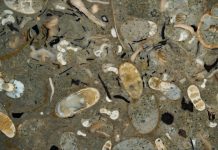
Who were the earliest ancestors of scorpions, spiders, and horseshoe crabs?
A Ph.D. student from the University of Lausanne in Switzerland, supported by a CNRS researcher, has discovered a fossil that helps answer this long-standing question.
This fossil bridges the gap between modern species and their ancient relatives from the Cambrian period, which dates back 505 million years, solving a significant paleontological mystery.
Modern scorpions, spiders, and horseshoe crabs belong to a large group of creatures called arthropods, which first appeared on Earth nearly 540 million years ago.
More specifically, these animals are part of a subgroup known as chelicerates.
Chelicerates are characterized by having pincers, which they use for various purposes like biting, grasping prey, or injecting venom.
But the question of what their earliest ancestors looked like has puzzled scientists for a long time.
Paleontologists have struggled to identify any ancient arthropods that had enough similarities to modern chelicerates to be considered their ancestors.
This challenge was made even harder by the lack of fossils from a key period between 505 and 430 million years ago, which would have been crucial for understanding their evolutionary history.
Lorenzo Lustri, a Ph.D. student at the University of Lausanne, has now found the missing piece of the puzzle.
Working with his supervisors, he studied over a hundred fossils from the Fezouata Shale in Morocco, which are around 478 million years old.
Among these, he identified a fossil that links modern chelicerates to those from the Cambrian period. The findings have been published in Nature Communications.
Fossils from the Fezouata Shale were first discovered in the early 2000s and have been extensively studied since.
However, one of the most common fossils in this deposit, measuring between 5 and 10 millimeters in size, had never been described before.
This fossil, now named Setapedites abundantis, provides the first complete link in the lineage of chelicerates, connecting the earliest arthropods to modern spiders, scorpions, and horseshoe crabs.
“We initially set out to describe and name this fossil without realizing its full significance,” says Lustri, the study’s lead author, who completed his Ph.D. in March 2023. “It was an exhilarating surprise to discover that it filled such an important gap in the evolutionary tree.”
While this fossil has provided many answers, it still holds more secrets. Some of its anatomical features offer new insights into the early evolution of chelicerates and may even help clarify the relationships of other mysterious fossils.
An exhibition on the Fezouata biota, in collaboration with the University of Lausanne, will soon be held at the Palais de Rumine in Lausanne, Switzerland.
To achieve these results, the scientists studied over a hundred fossils and used an X-ray scanner to reconstruct their detailed 3D anatomy. This allowed them to compare these fossils with numerous other fossil chelicerates from different sites, as well as their ancient relatives.
The importance of the Fezouata fossil was confirmed through phylogenetic analyses. These analyses use mathematical models to reconstruct the family tree of different species based on their anatomical traits.
Thanks to this work, scientists can now better understand the early ancestors of scorpions, spiders, and horseshoe crabs, providing a clearer picture of the evolutionary history of these fascinating creatures.
Source: KSR.



